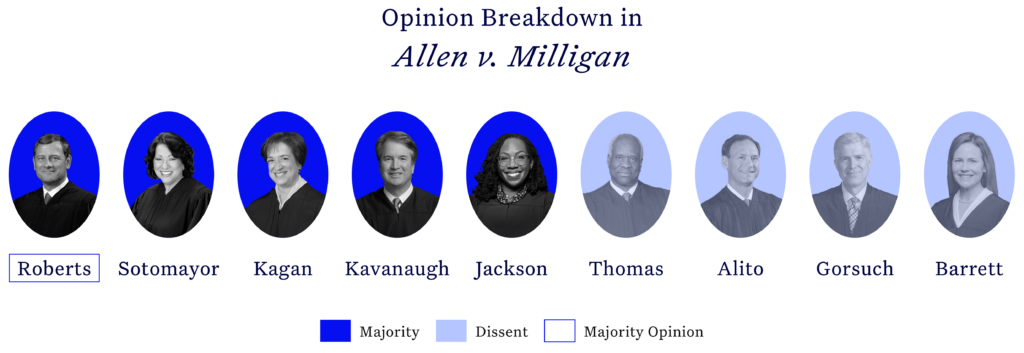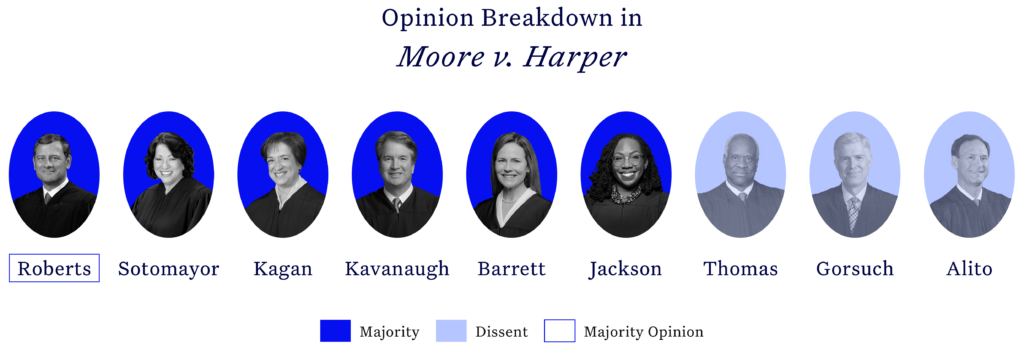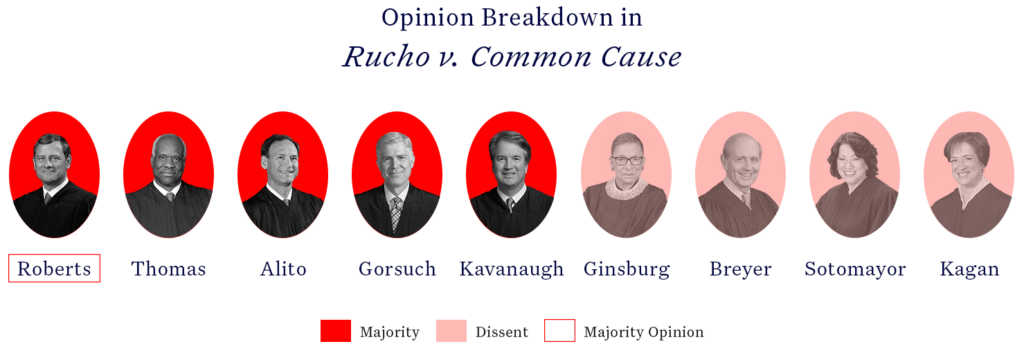As the nation’s highest court, the U.S. Supreme Court has wide-ranging power over the country’s judicial system. Accordingly, the Court has heard and decided an array of landmark voting rights and redistricting cases. This resource page contains everything you need to know about voting rights and redistricting cases that have been decided by the Supreme Court in recent years or will be decided next term, including case pages and related content.
Pending Cases
The U.S. Supreme Court will consider these cases next term.
Following the release of 2020 census data, the South Carolina State Conference of the NAACP filed a lawsuit challenging the state’s congressional and legislative maps for being malapportioned. Upon the enactment of new maps, the plaintiffs filed an amended complaint alleging that the maps are racially gerrymandered. In January 2023, a three-judge panel struck down the congressional map for being racially gerrymandered. South Carolina subsequently appealed the decision to the U.S. Supreme Court, which will hear the case next term. Oral argument is slated for Oct. 11, 2023.
Black voters in Arkansas challenged the state’s new congressional map, arguing it intentionally “cracks” Black voters across multiple congressional districts to dilute their voting strength, violating both state and federal law as well as Section 2 of the Voting Rights Act. The case was dismissed and the plaintiffs appealed the dismissal to the U.S. Supreme Court. This comes up as a direct appeal which means that the Supreme Court will either summarily reverse or affirm the dismissal or take up the case in full and issue a decision on the merits.
Decided Cases
2022-23 Term
The U.S. Supreme Court decided these cases during the 2022-23 term.
Voters and pro-voting groups filed two lawsuits arguing that Alabama’s congressional map diluted the voting strength of Black Alabamians, violating Section 2 of the Voting Rights Act (VRA). The cases were consolidated into Allen, and the U.S. Supreme Court, after previously pausing a lower court order that blocked the map, ruled in favor of the plaintiffs, leaving Section 2 of the VRA intact.

North Carolina voters and pro-voting groups filed a redistricting lawsuit challenging North Carolina’s congressional map for partisan gerrymandering. After the North Carolina Supreme Court ultimately struck down the congressional map for violating the state constitution, Republican legislators appealed to the U.S. Supreme Court and invoked the radical independent state legislature (ISL) theory. In raising the ISL theory, the Republicans argued that the Elections Clause of the U.S. Constitution grants state legislatures the sole authority to regulate federal elections and enact congressional maps, free from judicial review by state courts. The Court ultimately ruled against the North Carolina Republican legislators, rejecting the ISL theory.

2021-22 Term
The U.S. Supreme Court decided these cases during the 2021-22 term.
The North Carolina State Conference of the NAACP filed suit over Senate Bill 824, a bill that requires voters to provide one of 10 authorized photo IDs to vote either absentee or in person. Plaintiffs argued the bill disproportionately burdened minority voters, a violation of Section 2 of the VRA as well as the 14th and 15th amendments of the U.S. Constitution. State Republicans tried intervening in the case three times, failing each time. They subsequently asked the Supreme Court to grant them the right to intervene, and the Court did so. The Supreme Court reversed the lower courts’ judgment, ruling that the Republican state legislators were entitled to intervene in the lawsuit.
2020-21 Term
The U.S. Supreme Court decided these cases during the 2020-21 term.
The Democratic National Committee, Democratic Senatorial Campaign Committee and others filed a lawsuit against Arizona challenging two provisions of law that criminalized ballot collection and required ballots cast in the wrong precinct to be rejected. The practice was deemed discriminatory and struck down by the 9th U.S. Circuit Court of Appeals. The Republican attorney general of Arizona subsequently appealed to the U.S. Supreme Court, which overturned the decision, holding that neither law violated Section 2 of the VRA.

Previous Landmark Cases
The U.S. Supreme Court decided these landmark voting rights cases prior to 2020.
North Carolina voters and organizations challenged the state’s congressional map as a partisan gerrymander in violation of the U.S. constitution. Ultimately, a federal district court ruled in favor of the plaintiffs and struck down the map as a partisan gerrymander. The decision was appealed to the U.S. Supreme Court, which ruled that that partisan gerrymandering claims were nonjusticiable, meaning they are unsuitable for federal courts to review.


A lawsuit was filed on behalf of individual voters seeking to invalidate North Carolina’s 1st and 12th Congressional Districts for being racially gerrymandered in violation of the 14th Amendment’s Equal Protection Clause. A district court ruled that the North Carolina General Assembly had unlawfully used race to draw congressional districts. The decision was appealed to the U.S. Supreme Court, which upheld the prior ruling.
Following a decision by Arizona voters to adopt Proposition 106, an amendment to the state constitution that gave an independent commission redistricting authority, the Arizona Legislature sued over a subsequent state congressional map, arguing that the map-drawing process by the state’s independent redistricting commission violated the Elections Clause of the U.S. Constitution. A three-judge panel rejected the Legislature’s lawsuit, and the U.S. Supreme Court affirmed the decision, thereby holding that Arizona’s independent redistricting commission is constitutional.

Shelby County, Alabama filed a lawsuit seeking to strike down Section 5 of the Voting Rights Act (VRA) for being unconstitutional. Section 5 of the VRA mandated that certain “covered” jurisdictions with a history of discriminatory election laws must get federal pre-approval before any newly proposed voting legislation could go into effect. After a series of lower court defeats for Shelby County, it appealed the decision to the U.S. Supreme Court. The Court subsequently ruled in favor of Shelby County, concluding that the preclearance formula established by Section 4 of the VRA was unconstitutional, effectively gutting Section 5 of the VRA.

Following Election Day in 2000, the certification of Florida’s presidential election results came under intense controversy. Multiple lawsuits were filed surrounding overvotes and undervotes, and the design of the ballots. The Florida Supreme Court ordered manual recounts in a slew of counties, and the Bush campaign subsequently filed an emergency application to the U.S. Supreme Court asking to pause the state Supreme Court’s order. The request was granted, and the Court ultimately reversed the Florida Supreme Court decision on the merits, effectively handing Bush the presidency.

From our desk
From Marc
How the Supreme Court Turned a Community Leader into a Criminal
In 2016, the Arizona Legislature passed a ban on ballot collection that was aimed at decreasing electoral participation by minorities, especially among the state’s large Latino community.
In a Major Victory, the Supreme Court Didn’t Break Democracy
Ten years after Chief Justice John Roberts struck down Section 5 in Shelby County, he spared a different critical provision of the Voting Rights Act.
A Dangerous Legal Theory Is Rejected
Writing for a six-justice majority, Chief Justice John Roberts firmly rejected the so-called independent state legislature theory.
Podcast episodes
from our guest authors
Louisiana Gets a Shot at Fair Maps After Supreme Court Ruling in Allen v. Milligan
Most people who work on, or follow, civil rights issues in the U.S. woke up on Thursday, June 8, 2023, with a feeling of impending doom.
The U.S. Supreme Court’s Supreme Takeover
As the final decisions of the term dropped, it was clear this Court is as extreme as ever.
Saving Our Courts Means Questioning All U.S. Supreme Court Norms
My guiding principle is simple: The public deserves to understand the operations and decisions of its Court.